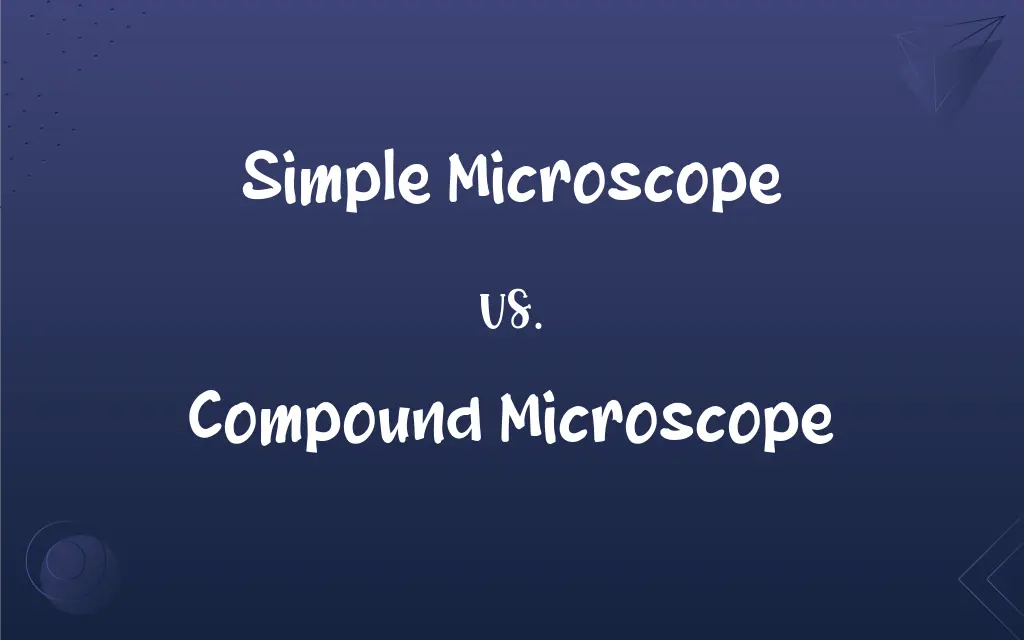Simple Microscope vs. Compound Microscope: What's the Difference?
Edited by Janet White || By Harlon Moss || Published on January 1, 2024
A simple microscope uses a single lens for magnification, while a compound microscope uses multiple lenses for higher magnification and resolution.

Key Differences
A simple microscope uses a single lens, similar to a magnifying glass, for basic magnification. A compound microscope, on the other hand, employs a system of multiple lenses, typically two: the objective and the eyepiece lens, for greater magnification and clarity.
The magnification of a simple microscope is generally lower, suitable for basic observation. Compound microscopes offer much higher magnification, essential for detailed study of microorganisms, cells, and tissues.
Simple microscopes are easier to use and more portable, ideal for simple tasks. Compound microscopes, with their intricate lens systems and adjustments, are used for complex and detailed scientific research.
The resolution in a simple microscope is limited, showing less detail. In contrast, compound microscopes provide higher resolution, allowing for the observation of finer details and structures.
Simple microscopes are often used in education and for hobbyist purposes. Compound microscopes are crucial in laboratories, medical research, and advanced educational settings for detailed cellular and microbiological studies.
ADVERTISEMENT
Comparison Chart
Lens System
Single lens
Multiple lenses (objective and eyepiece)
Magnification
Lower magnification
Higher magnification
Complexity
Less complex, easy to use
More complex, requires training
Resolution
Limited resolution
High resolution
Primary Use
Education, hobbyist activities
Scientific research, medical applications
ADVERTISEMENT
Simple Microscope and Compound Microscope Definitions
Simple Microscope
It's a basic form of microscope with limited magnification.
The simple microscope is perfect for quick observations of everyday objects.
Compound Microscope
A compound microscope uses a series of lenses for high magnification.
Scientists rely on a compound microscope for cellular research.
Simple Microscope
Simple microscopes are portable and easy to use.
A jeweler often uses a simple microscope to inspect gems.
Compound Microscope
Compound microscopes can magnify objects hundreds or thousands of times.
Using a compound microscope, researchers observed the detailed behavior of microorganisms.
Simple Microscope
A simple microscope typically magnifies objects up to 10 times.
He used a simple microscope to examine the details of a coin's surface.
Compound Microscope
These microscopes require careful handling and calibration.
Students in a biology lab learn to meticulously adjust a compound microscope.
Simple Microscope
A simple microscope is an optical instrument using one lens to magnify objects.
A child used a simple microscope to examine leaves in the backyard.
Compound Microscope
Compound microscopes are essential tools in advanced scientific studies.
In microbiology labs, the compound microscope is indispensable for observing bacteria.
Simple Microscope
This microscope is ideal for beginners or educational purposes.
In elementary schools, a simple microscope introduces students to the world of microscopy.
Compound Microscope
It offers greater resolution and clarity than a simple microscope.
The compound microscope revealed the intricate structures within a plant cell.
FAQs
What is a simple microscope?
A simple microscope is an optical device with a single lens used for magnification.
What is a compound microscope?
A compound microscope is a more complex microscope using multiple lenses for higher magnification.
What is the magnification range of a compound microscope?
Compound microscopes can magnify objects from 40 to 1000 times or more.
Are compound microscopes used in professional settings?
Yes, compound microscopes are widely used in professional and scientific research settings.
Do compound microscopes need special care?
Yes, compound microscopes require careful handling and regular maintenance.
How much can a simple microscope magnify?
A simple microscope typically magnifies up to 10 times.
Is a simple microscope portable?
Yes, simple microscopes are known for their portability and ease of use.
Where are simple microscopes commonly used?
Simple microscopes are commonly used in education, jewelry inspection, and by hobbyists.
Can children use simple microscopes?
Yes, simple microscopes are often used by children for basic observation.
Can simple microscopes be used for medical diagnosis?
Simple microscopes are not typically used for medical diagnosis due to their limited magnification.
What makes compound microscopes suitable for research?
Their higher magnification and resolution make compound microscopes suitable for detailed scientific research.
How do you adjust the magnification on a compound microscope?
The magnification on a compound microscope is adjusted by changing the objective lenses.
Can a simple microscope show cell structures?
A simple microscope can show basic cell structures but lacks the detail provided by a compound microscope.
Do simple microscopes require electricity?
No, simple microscopes generally do not require electricity.
Are compound microscopes expensive?
Yes, due to their complexity, compound microscopes are generally more expensive than simple ones.
What are the power sources for compound microscopes?
Compound microscopes are usually powered by electricity, either through a power cord or batteries.
Can a simple microscope view bacteria?
Viewing bacteria typically requires the higher magnification provided by a compound microscope.
Is special training needed to use a compound microscope?
Basic training or guidance is recommended for proper use of a compound microscope.
How do you clean a compound microscope?
Compound microscopes should be cleaned carefully with appropriate lens cleaning solutions and materials.
Are there digital versions of compound microscopes?
Yes, there are digital compound microscopes that connect to computers for image analysis and storage.
About Author
Written by
Harlon MossHarlon is a seasoned quality moderator and accomplished content writer for Difference Wiki. An alumnus of the prestigious University of California, he earned his degree in Computer Science. Leveraging his academic background, Harlon brings a meticulous and informed perspective to his work, ensuring content accuracy and excellence.
Edited by
Janet WhiteJanet White has been an esteemed writer and blogger for Difference Wiki. Holding a Master's degree in Science and Medical Journalism from the prestigious Boston University, she has consistently demonstrated her expertise and passion for her field. When she's not immersed in her work, Janet relishes her time exercising, delving into a good book, and cherishing moments with friends and family.






































































